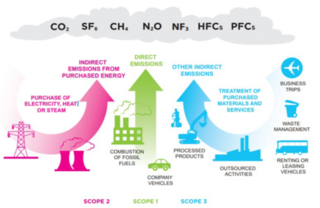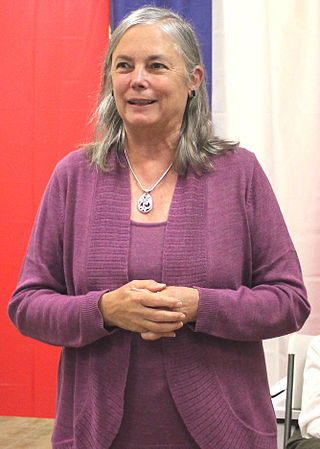The United Nations Framework Convention on Climate Change (UNFCCC) established an international environmental treaty to combat "dangerous human interference with the climate system", in part by stabilizing greenhouse gas concentrations in the atmosphere. It was signed by 154 states at the United Nations Conference on Environment and Development (UNCED), informally known as the Earth Summit, held in Rio de Janeiro from 3 to 14 June 1992. Its original secretariat was in Geneva but relocated to Bonn in 1996. It entered into force on 21 March 1994.

Carbon offsetting is a trading mechanism that allows entities such as governments, individuals, or businesses to compensate for (i.e. “offset”) their greenhouse gas emissions by supporting projects that reduce, avoid, or remove emissions elsewhere. A carbon credit or offset credit is a transferable financial instrument, that is a derivative of an underlying commodity. It can be bought or sold after certification by a government or independent certification body. When an entity invests in a carbon offsetting program, it receives carbon credits, i.e "tokens" used to account for net climate benefits from one entity to another. One carbon offset or credit represents a reduction, avoidance or removal of one tonne of carbon dioxide or its carbon dioxide-equivalent (CO2e). Offset projects that take place in the future can be considered to be a type of promissory note: The purchaser of the offset credit pays carbon market rates for the credits and in turn receives a promise that the purchaser's greenhouse emissions generated in the present (e.g. a roundtrip flight to London) will be offset by elimination of an equal amount at some point in the future (e.g. 10 to 20 years for planting 110 seedlings). Offsets that were generated in the past are credible only if they were in addition to reductions that would have happened anyway.

Carbon accounting is a framework of methods to measure and track how much greenhouse gas (GHG) an organization emits. It can also be used to track projects or actions to reduce emissions in sectors such as forestry or renewable energy. Corporations, cities and other groups use these techniques to help limit climate change. Organizations will often set an emissions baseline, create targets for reducing emissions, and track progress towards them. The accounting methods enable them to do this in a more consistent and transparent manner.
Greenhouse gas inventories are emission inventories of greenhouse gas emissions that are developed for a variety of reasons. Scientists use inventories of natural and anthropogenic (human-caused) emissions as tools when developing atmospheric models. Policy makers use inventories to develop strategies and policies for emissions reductions and to track the progress of those policies.
The Global Warming Solutions Act of 2006, or Assembly Bill (AB) 32, is a California State Law that fights global warming by establishing a comprehensive program to reduce greenhouse gas emissions from all sources throughout the state. AB32 was co-authored by then-Assemblymember Fran Pavley and then-Speaker of the California Assembly Fabian Nunez and signed into law by Governor Arnold Schwarzenegger on September 27, 2006.

Frances J. "Fran" Pavley is an American politician who served two terms in the California State Senate and three terms in the California State Assembly. A Democrat, she last represented the 27th Senate District, which encompasses the Conejo Valley, and portions of the San Fernando and Santa Clarita Valleys. Due to term limits in California, Senator Pavley completed her legislative career in 2016. She is currently working as the Environmental Policy Director for the USC Schwarzenegger Institute.
The Investor Network on Climate Risk (INCR) is a nonprofit organization of investors and financial institutions that promotes better understanding of the financial risks and investment opportunities posed by climate change. INCR is coordinated by Ceres, a coalition of investors and environmental groups working to advance sustainable prosperity.

The Climate Registry (TCR) is a non-profit organization governed by U.S. states and Canadian provinces and territories. TCR designs and operates voluntary and compliance greenhouse gas (GHG) reporting programs globally, and assists organizations in measuring, reporting and verifying the carbon in their operations in order to manage and reduce it. TCR also consults with governments nationally and internationally on all aspects of GHG measurement, reporting, and verification.

The United States produced 5.2 billion metric tons of carbon dioxide equivalent greenhouse gas (GHG) emissions in 2020, the second largest in the world after greenhouse gas emissions by China and among the countries with the highest greenhouse gas emissions per person. In 2019 China is estimated to have emitted 27% of world GHG, followed by the United States with 11%, then India with 6.6%. In total the United States has emitted a quarter of world GHG, more than any other country. Annual emissions are over 15 tons per person and, amongst the top eight emitters, is the highest country by greenhouse gas emissions per person. However, the IEA estimates that the richest decile in the US emits over 55 tonnes of CO2 per capita each year. Because coal-fired power stations are gradually shutting down, in the 2010s emissions from electricity generation fell to second place behind transportation which is now the largest single source. In 2020, 27% of the GHG emissions of the United States were from transportation, 25% from electricity, 24% from industry, 13% from commercial and residential buildings and 11% from agriculture. In 2021, the electric power sector was the second largest source of U.S. greenhouse gas emissions, accounting for 25% of the U.S. total. These greenhouse gas emissions are contributing to climate change in the United States, as well as worldwide.
The Emissions & Generation Resource Integrated Database (eGRID) is a comprehensive source of data on the environmental characteristics of almost all electric power generated in the United States. eGRID is issued by the U.S. Environmental Protection Agency (EPA).

Carbon emission trading (also called emission trading scheme (ETS) or cap and trade) is a type of emission trading scheme designed for carbon dioxide (CO2) and other greenhouse gases (GHG). It is a form of carbon pricing. Its purpose is to limit climate change by creating a market with limited allowances for emissions. This can lower competitiveness of fossil fuels and accelerate investments into low carbon sources of energy such as wind power and photovoltaics. Fossil fuels are the main driver for climate change. They account for 89% of all CO2 emissions and 68% of all GHG emissions.

The New England Governors and Eastern Canadian Premiers (NEG-ECP) Climate Change Action Plan 2001 is a resolution adopted on August 28, 2001, by the New England Governors and the Eastern Canadian Premiers. The resolution calls for a reduction in greenhouse gas (GHG) emissions to 1990 levels by 2010, at least 10% below 1990 levels by 2020, 35-45% below 1990 levels by 2030, and a 75-85% reduction of 2001 levels by 2050.

The climate change policy of the United States has major impacts on global climate change and global climate change mitigation. This is because the United States is the second largest emitter of greenhouse gasses in the world after China, and is among the countries with the highest greenhouse gas emissions per person in the world. In total, the United States has emitted over 400 billion metric tons of greenhouse gasses, more than any country in the world.
The Copenhagen Accord is a document which delegates at the 15th session of the Conference of Parties to the United Nations Framework Convention on Climate Change agreed to "take note of" at the final plenary on 18 December 2009.
The California Sustainability Alliance is an organization funded by the California IOUs, to facilitate discussions between various industries on the issues of resource sustainability. The Alliance was set up in 2008 to help California meet its goals in facing Climate change in the State, in relation to energy, resources, and the environment. Efforts are directed at increasing and accelerating sustainable measures and strategies. The Alliance specifically focuses on energy efficiency, climate action, “smart growth” principles, renewable energy development, water-use efficiency, waste management, and transportation management within California.
American Electric Power Company v. Connecticut, 564 U.S. 410 (2011), was a United States Supreme Court case in which the Court, in an 8–0 decision, held that corporations cannot be sued for greenhouse gas emissions (GHGs) under federal common law, primarily because the Clean Air Act (CAA) delegates the management of carbon dioxide and other GHG emissions to the Environmental Protection Agency (EPA). Brought to court in July 2004 in the Southern District of New York, this was the first global warming case based on a public nuisance claim.
The, United States Environmental Protection Agency (EPA) began regulating greenhouse gases (GHGs) under the Clean Air Act from mobile and stationary sources of air pollution for the first time on January 2, 2011. Standards for mobile sources have been established pursuant to Section 202 of the CAA, and GHGs from stationary sources are currently controlled under the authority of Part C of Title I of the Act. The basis for regulations was upheld in the United States Court of Appeals for the District of Columbia in June 2012.
Litigation related to climate change and greenhouse gas (GHG) emissions has become increasingly common in federal and state courts. Following adoption of the Global Warming Solutions Act of 2006 and publication of the Intergovernmental Panel on Climate Change (IPCC) Fourth Assessment Report (AR4), additional pressure was placed on California public agencies to evaluate potential adverse effects to global climate change caused by GHG emissions. In particular, several lawsuits have been filed against agencies for failure to analyze GHG emissions generated by projects subject to the California Environmental Quality Act (CEQA). Court decisions prior to the 2010 revisions to the CEQA guidelines gave early insights as to how CEQA would be used as a vehicle to identify and mitigate GHG emissions within the state. Decisions issued after adoption of the revised guidelines are now being used to interpret CEQA's new requirement to evaluate GHG emissions and climate change.

The California Global Warming Solutions Act of 2016: emissions limit, or SB-32, is a California Senate bill expanding upon AB-32 to reduce greenhouse gas (GHG) emissions. The lead author is Senator Fran Pavley and the principal co-author is Assemblymember Eduardo Garcia. SB-32 was signed into law on September 8, 2016, by Governor Edmund Gerald “Jerry” Brown Jr. SB-32 sets into law the mandated reduction target in GHG emissions as written into Executive Order B-30-15.

The Initial IMO Strategy on the reduction of GHG emissions from ships, or Initial IMO GHG Strategy, is the framework through which the International Maritime Organization (IMO) aims to reduce greenhouse gas (GHG) emissions from international maritime shipping. GHG emissions from shipping are about 3% of total GHG emissions, and under this strategy the IMO envisions their elimination within this century. However many companies and organizations say shipping should be decarbonized by 2050.










